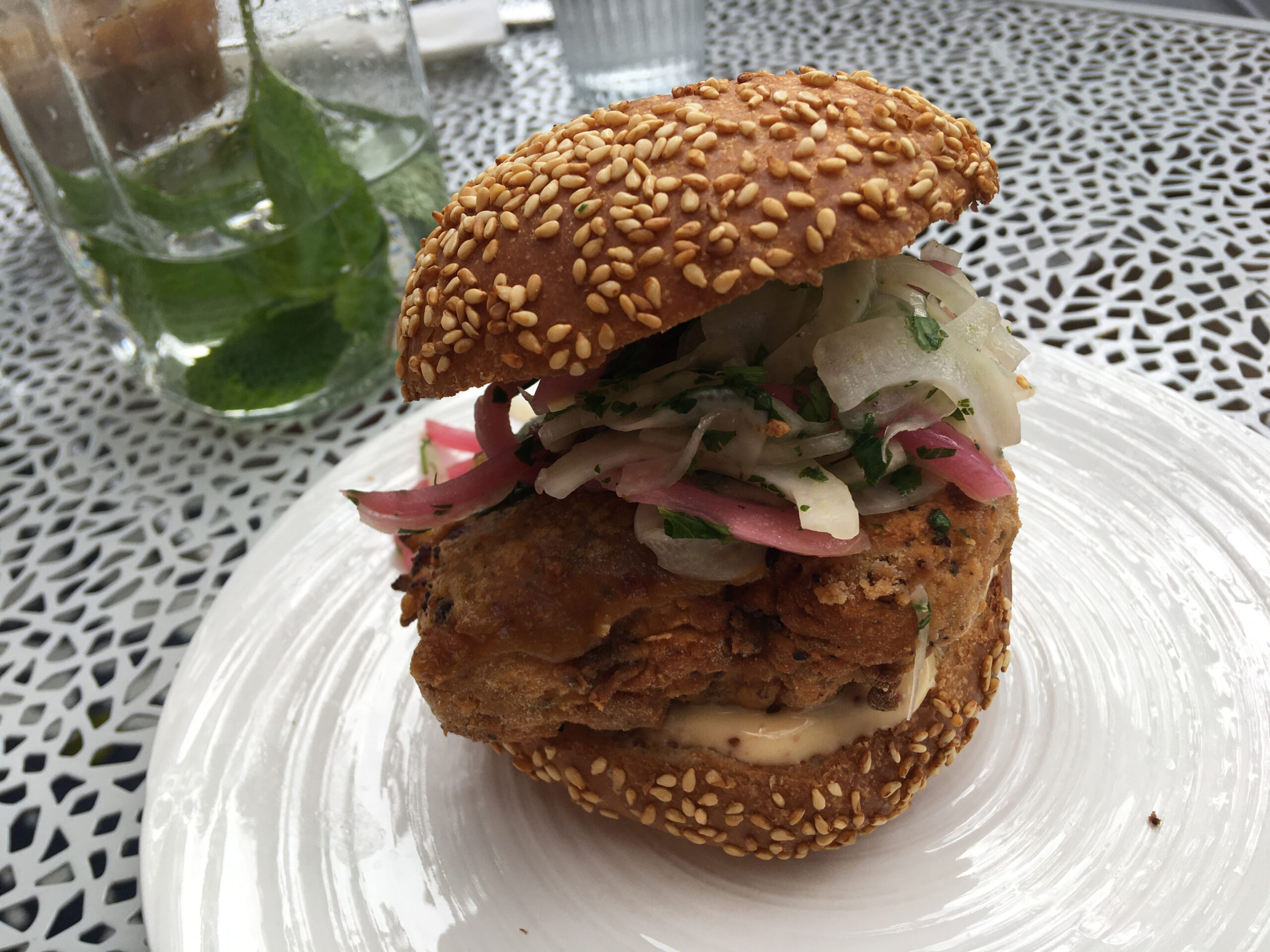Chef Mona Leena’s new restaurant, Lulu, doesn’t serve shawarma. “This is a California restaurant with Palestinian inspirations,” Leena said. “You’ll see familiar Palestinian ingredients and flavors, but it isn’t a place where you can order a mixed grill.” There is a familiar falafel bowl, perhaps defamiliarized with garlic-fried freekeh and zhough. The chef’s fried-chicken sandwich includes a fennel slaw and aleppo mayonnaise served on a homemade simsim or sesame bun.
“We make our buns in-house,” Leena said. “They’re reminiscent of Jerusalem bagels; coated with a ton of sesame seeds, crispy on the outside and fluffy on the inside.” After ordering the fried-chicken sandwich for an early lunch, I agreed with the chef’s claim that the bun is ideal for holding a sandwich together. She was proud to say that, in a departure from many other restaurants, Lulu’s uses chicken breasts instead of thighs. Leena divulged some but not all of the ingredients that contribute to the chicken tasting “salty, fennelly and fragrant.”
The glaze, which, she says, recalls Nobu’s miso cod marinade, is a reduction of white miso, orange juice and arak, an Arabic version of ouzo. “You feel the heat from the aleppo, the fragrance from the fennel and brightness from the pickled onion,” Leena said, nearly rhapsodizing. “It’s just complex and umami.”
Lulu, the chef’s childhood nickname, is the culmination of her working life. “Everything I’ve learned at past restaurants,” she said, “and the cuisines I’ve experienced, coming together with a little Palestinian flavor to it.”
I arrived some 15 minutes after the kitchen stopped serving breakfast. I was particularly interested in the Lulu breakfast bowl, served with house labneh, a jammy egg, seasonal crudite and za’atar sticks. Switching gears to luncheon mode, I noticed that one sandwich had landed on both sides of the menu.
Halloumi and preserves is a slightly confounding dish. It’s both sweet and savory, a grilled cheese sandwich topped with jam and arugula. Halloumi, like many similar cheeses, is a lot to take in huge doses. I wanted more acidity, a thick tomato slice, a carrot and cabbage slaw or sautéed zucchini to contend with all that hallouminess. As a starter, I had also ordered a salad with fresh tomatoes, cucumbers and a thick slab of halloumi. I loved the way the vegetables were seasoned and dressed, but a few halloumi crumbles would have made the same cheesy point, though less emphatically.
Chef Leena was working at Daniel Patterson’s Dyafa when the pandemic came to town. After its doors shuttered, she started a pop-up called The Mana’eesh Lady. The hot ticket item was the manousheh, a flatbread topped with varying ingredients. “The idea [behind breakfast at Lulu] was to have an ode to The Mana’eesh Lady—manousheh, a few baked goods and a really great coffee program,” she said. “I really wanted to do breakfast and lunch on the weekdays and a full-service brunch on the weekends.” As Leena astutely observed before moving into the space on Camelia Street, there were few options in the Gilman District for neighborhood residents to grab an espresso.
Several chefs I’ve spoken with in the past year became adept at using social media to publicize their businesses. Leena believes that The Mana’eesh Lady wouldn’t have taken off in the same way it did without Instagram. A newspaper article boosted interest, too, but she says, “It was really the Oakland and East Bay chef community that supported each other during the pandemic.” Now that she has a full-time brick-and-mortar restaurant to run, Leena has, for the most part, turned social media posting over to one of her employees.
Leena figured out that, “People love to see your face, to see videos of the food you’re creating.” They also love the sense of involvement. “If you’re posting and then not responding to comments and messages, and not reposting other people’s food menus, then it’s pointless.” The whole point, she says, is to engage with your customers. “It makes them feel like they’re closer to you and therefore want to support you even more.”






